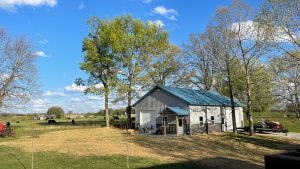The recent National Frame Building Association (NFBA) 2014 Frame Building Expo was a reunion event for me with several long-time friends. One of these is Ferg Evans.
In the 1990’s I was elected to the first of five terms I was to serve on the Board of Directors for the Machine Stress Rated Lumber Producers Council (www.msrlumber.org). One of my fellow board members was Ferg Evans.
The MSR Lumber Producers Council was coincidentally formed on my 30th birthday, with Ferg Evans as one of the original board members!
Ferg is now the Managing Partner of Canadian Engineered Wood Products, Ltd. (www.cewp.ca). Canadian Engineered Wood Products are the distributors for what I feel is a pretty slick product (at least from my pre-fabricated metal connector plated truss background).
 Manufactured by Pinkwood, Ltd. (www.pinkwood.ca), of Calgray, Alberta, Canada is FJLumber. FJLumber (finger jointed lumber) is quality long length lumber designed specifically for the truss industry (although I can think of many other uses for it). It is produced in one foot increments up to FORTY-EIGHT feet long!! In 2×4 and 2×6 it is available in msr grades of 2100f and 2400f, and in 2×8 1950f.
Manufactured by Pinkwood, Ltd. (www.pinkwood.ca), of Calgray, Alberta, Canada is FJLumber. FJLumber (finger jointed lumber) is quality long length lumber designed specifically for the truss industry (although I can think of many other uses for it). It is produced in one foot increments up to FORTY-EIGHT feet long!! In 2×4 and 2×6 it is available in msr grades of 2100f and 2400f, and in 2×8 1950f.
In the manufacturing process, short lengths of lumber are graded for strength first. Next, these short pieces are structurally finger jointed to each other using an ASTM (American Society for Testing and Materials) approved, heat resistant adhesive. Each newly created finger joint is in-line tension tested to 1.5 times the design specifications to insure structural integrity.
Consider this – a 2×6 #2 grade in Douglas Fir has an Fb (fiberstress in bending) value of 1170 psi (pounds per square inch); Canadian Spruce-Pine-Fir (SPF) 1137.5; U.S. Hem-Fir 1105 and Southern Yellow Pine 1000. This makes a 2×6 2400f msr graded board over TWICE as strong in bending as any of the above listed popular framing lumber!!
Now I’ve spent years look at trusses, and have a fair idea of what it is I am seeing. For a lay person, they might notice the horizontal bottom member (or bottom chord) of a truss, is not a continuous single piece of lumber (unless the span of the truss is very small). The bottom chord is typically comprised of several pieces of lumber, which have been spliced end-to-end by pressed in steel connector plates.
For a truss manufacturer, being able to get 48 foot long finger jointed lumber eliminates most instances of having to use metal connector plates for chord splicing. Besides the labor savings and cost of the plates, it also allows for greater flexibility of the truss fabricator on where webs (internal truss members) can intersect the chords (there are rules about where webs can be placed in relationship to splices).
Besides solving problems for the truss people, I’d think this could be a pretty handy way to solve some structural issues with pole building wall girts. As a builder – walls would certainly frame up quick, with the use of only a single board to do an entire girt row on a 48 foot length building!






